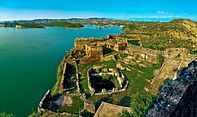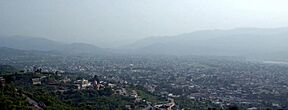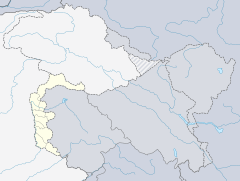Mirpur, Azad Kashmir facts for kids
Quick facts for kids
Mirpur
میرپور
|
|
|---|---|
|
City
|
|
| New Mirpur City | |
|
Clockwise from the top:
Mirpur City, Ramkot Fort, Panoramic view of the city, Tomb of Mian Muhammad Bakhsh, |
|
| Nickname(s):
Little England
|
|
| Country | Pakistan |
| Territory | Azad Kashmir |
| Division | Mirpur |
| District | Mirpur |
| Government | |
| • Type | Municipal Corporation |
| • Body | Mirpur Development Authority |
| Elevation | 458 m (1,503 ft) |
| Population
(2017)
|
|
| • City | 124,352 |
| • Rank | 74th, Pakistan |
| Languages | |
| • Official | Urdu |
| • Spoken | |
| Time zone | UTC+5 (PKT) |
| Calling code | 05827 |
| Number of Tehsils | 3 |
| Number of Union councils | 21 |
Mirpur, also known as New Mirpur City, is an important city in Azad Kashmir, Pakistan. It is the capital of the Mirpur district. Mirpur is the second largest city in Azad Kashmir and the 74th largest city in Pakistan.
Many people from Mirpur and the surrounding area moved to the United Kingdom in the 1950s and 1960s. They mostly settled in places like West Yorkshire, the Midlands, Birmingham, and East London. Because of this, Mirpur is sometimes called "Little England." You can even find many British products there, and some shops accept the British pound sterling currency.
The city of Mirpur has become quite modern. However, the areas around it still mostly rely on farming.
Contents
Exploring Mirpur's Past
The city of Mirpur was founded around the year 1640 AD. It was started by a local leader named Miran Shah Ghazi during the time of the Mughal Empire. Some stories also say that Gosain Bodhpuri, another saint, helped found the city. The name 'Mirpur' comes from 'Mir' (from Miran Shah Ghazi) and 'Pur' (from Bodhpuri).
Mirpur's Place in History
The area where Mirpur is located was historically part of the Pothohar Plateau region in northern Punjab. Later, in the late 1700s, Mirpur became part of a state called Chibb. This state had its capital at Mangla Fort.
Joining the Sikh Empire
In the early 1800s, a powerful leader named Maharaja Ranjit Singh took control of the Punjab region. His army defeated the local rulers, and Mirpur became part of his growing Sikh Empire.
Becoming Part of Jammu and Kashmir
After some time, Ranjit Singh gave control of Jammu to his commander, Gulab Singh. Gulab Singh continued to expand his territory. In 1846, after a war, the British signed a treaty with Gulab Singh. This treaty sold Kashmir to him, and Mirpur became part of the new state of Jammu and Kashmir.
Old Mirpur and River Trade
Mirpur was once a very important place for building boats. It was located where the Jhelum River met the mountains. This was perfect for making boats that carried goods from the Himalayas down the rivers to the Indus River and then to seaports. Many boat builders and boatmen came from Mirpur.
Changes During British Rule
When the British ruled, new railway lines were built. This made river trade less important, and Mirpur's boat-building industry declined.
Independence and the New City
After Partition of India in 1947, Mirpur became part of Azad Kashmir. The original city of Mirpur was later submerged when the Mangla Dam was built in the 1960s. A new city, called New Mirpur City, was then built on the banks of the Mangla Lake to house the people who had to move.
Mirpur's Location and Weather
Mirpur is located at the foot of the Himalayas mountains. It is about 458 meters (1,503 feet) above sea level. The city is connected to the main Peshawar-Lahore Grand Trunk Road at Dina Tehsil. Mirpur is now one of the largest cities in Azad Kashmir.
Climate
Mirpur has a climate that is hot and humid, especially in summer. It is very similar to nearby areas in Pakistan like Jehlum. The city gets a good amount of rain each year, around 1,380 millimeters (54 inches).
| Climate data for Mirpur, Azad Kashmir | |||||||||||||
|---|---|---|---|---|---|---|---|---|---|---|---|---|---|
| Month | Jan | Feb | Mar | Apr | May | Jun | Jul | Aug | Sep | Oct | Nov | Dec | Year |
| Mean daily maximum °C (°F) | 18.8 (65.8) |
21.4 (70.5) |
27.8 (82.0) |
33.9 (93.0) |
39.2 (102.6) |
41.0 (105.8) |
37.0 (98.6) |
34.5 (94.1) |
34.3 (93.7) |
31.4 (88.5) |
26.8 (80.2) |
21.1 (70.0) |
30.6 (87.1) |
| Mean daily minimum °C (°F) | 3.9 (39.0) |
6.1 (43.0) |
10.1 (50.2) |
13.8 (56.8) |
19.4 (66.9) |
23.4 (74.1) |
27.4 (81.3) |
27.6 (81.7) |
26.7 (80.1) |
18.5 (65.3) |
10.3 (50.5) |
4.2 (39.6) |
15.9 (60.7) |
| Average rainfall mm (inches) | 78 (3.1) |
142 (5.6) |
139 (5.5) |
98 (3.9) |
44 (1.7) |
98 (3.9) |
281 (11.1) |
270 (10.6) |
104 (4.1) |
38 (1.5) |
36 (1.4) |
48 (1.9) |
1,376 (54.3) |
| Average rainy days (≥ 1.0 mm) | 5 | 7 | 8 | 7 | 8 | 9 | 19 | 20 | 11 | 4 | 2 | 3 | 103 |
| Average relative humidity (%) | 66 | 64 | 57 | 45 | 35 | 43 | 71 | 78 | 70 | 57 | 58 | 62 | 59 |
Mirpur's Industries
The government of Azad Jammu and Kashmir has worked to develop industries in Mirpur. This has encouraged private businesses to invest in different areas. Some of the products made here include:
- Foam
- Synthetic yarn
- Motorbikes and scooters
- Textiles
- Vegetable oil (ghee)
- Wood products
- Soap
- Cosmetics
- Marble
- Ready-made clothes
- Matches
- Rosin and turpentine
Mirpur's economy helps the overall economy of Azad Kashmir. There is ongoing construction around the district by Pakistani and Chinese companies to improve the dam and the city's infrastructure. New towns are also being planned to help people who were affected by the dam project.
Learning in Mirpur
English is commonly used in schools and colleges in Mirpur. The city has several important educational institutions:
- The University of Azad Jammu & Kashmir
- The Mirpur University of Science and Technology (MUST)
- The Akson College of Health Science
- The Mohtarma Benazir Bhutto Shaheed Medical College
The AJK Board of Intermediate and Secondary Education, Mirpur manages studies at lower school levels. Besides government schools, many private schools and colleges also offer education in Mirpur.
Some other well-known colleges and schools include:
- The City School
- Mohi ud Din Islamic Institute of Pharmaceutical Sciences
- Mohi-ud-Din Islamic Medical College
- Punjab College, Mirpur
- Roots Millennium Schools
- Beaconhouse School System
Sports and Fun
Football, cricket, and volleyball are very popular sports in Mirpur. The city has a cricket stadium called Quaid-e-Azam Stadium.
There are several registered sports clubs in Mirpur. Al-Fatah Cricket Club is one of the top clubs in the city. Other cricket clubs include Eagle Star Cricket Club and South Asia Cricket Club. Some notable cricketers from the area include Zaman Khan, Hassan Raza, and Shadab Khan.
Football clubs like Pilot Football Club, Youth Football Club, and Kashmir National FC are also active. The district football team of Mirpur takes part in the All Azad Jammu and Kashmir football championships.
Getting Around Mirpur
CNG auto-rickshaws are a very common way to travel short distances within the city. Mirpur's transport system connects it to many places in Azad Kashmir, such as Bhimber, Jatlan, and Kotli. It also connects to major cities in Pakistan like Gujrat, Jhelum, and Lahore.
There is no railway station directly in Mirpur. The closest one is in Dina. There are plans for an international airport near Mirpur, possibly in Mangla, Jatlan, or Bhalwhara.
Mirpur's People
According to the 2017 census, Mirpur had a population of 124,352 people. The original population of Mirpur includes different groups of people, similar to those found in Punjab. After 1947, many people from the nearby Rajouri and Poonch districts of Indian-administered Jammu and Kashmir settled in Mirpur city and the surrounding areas. As mentioned earlier, a large number of people from Mirpur now live in England.
Diverse Communities in Mirpur's Past
Before 1947, the Mirpur District was home to a diverse population, including many Hindu and Sikh communities. These groups made up a significant part of Mirpur city's population. During the First Kashmir War in 1947, the city experienced conflict. Many people from these communities moved to other areas, including Jammu and other parts of India.
Places to See in Mirpur
Here are some interesting places to visit in Mirpur:
- Khari Sharif Darbar
- Mangla Dam
- Mangla Fort
- Ramkot Fort
Famous People from Mirpur
Many notable people have come from Mirpur:
- Nazir Ahmed, Baron Ahmed – a former member of the British House of Lords.
- Rehman Chishti – a Member of the British Parliament.
- Khalid Mahmood – a Member of the British Parliament.
- Mohammad Yasin MP – a British Member of Parliament.
- Mian Muhammad Bakhsh – a famous Sufi saint and poet.
- Sultan Mehmood Chaudhry – a politician who has served as President of Azad Kashmir.
- Zaman Khan – a cricketer.
- Chaudhry Abdul Majid – a politician who served as the Prime Minister of Azad Jammu and Kashmir.
- Afaq Raheem – a first-class Pakistani cricketer.
- Baba Shadi Shaheed – a Sufi saint.
- Jamil Rahmat Vance – a retired Two Star General of the Pakistan Army.
- Krishan Dev Sethi – a social and political leader.
Friendship Cities
Mirpur has friendly connections with several cities in England, United Kingdom:
 Birmingham, England
Birmingham, England Bradford, England
Bradford, England London, England
London, England






